Corporate Level Marketing Strategies of Nestle: A Detailed Report
VerifiedAdded on 2022/11/28
|28
|6727
|105
Report
AI Summary
This report provides a comprehensive analysis of Nestle's corporate-level marketing strategies. It begins with an overview of Nestle's business and its diverse product portfolio, followed by an exploration of its marketing strategies using the 8 Ps framework. The report then delves into the macro and micro environmental analysis of Nestle, employing tools such as PESTEL and Porter's 5 Forces to assess external factors and competitive dynamics. A SWOT analysis is conducted to evaluate internal strengths, weaknesses, opportunities, and threats. The value chain analysis examines Nestle's internal activities, including inbound logistics, operations, outbound logistics, marketing and sales, and services. Stakeholder management is also considered. The report further analyzes Nestle's marketing strategies using the Ansoff Matrix and Porter's Generic Competitive Strategies to understand its growth and competitive positioning. Finally, a suitability model is used to evaluate the effectiveness of these strategies. The report concludes with a summary of the key findings and insights into Nestle's marketing approach.
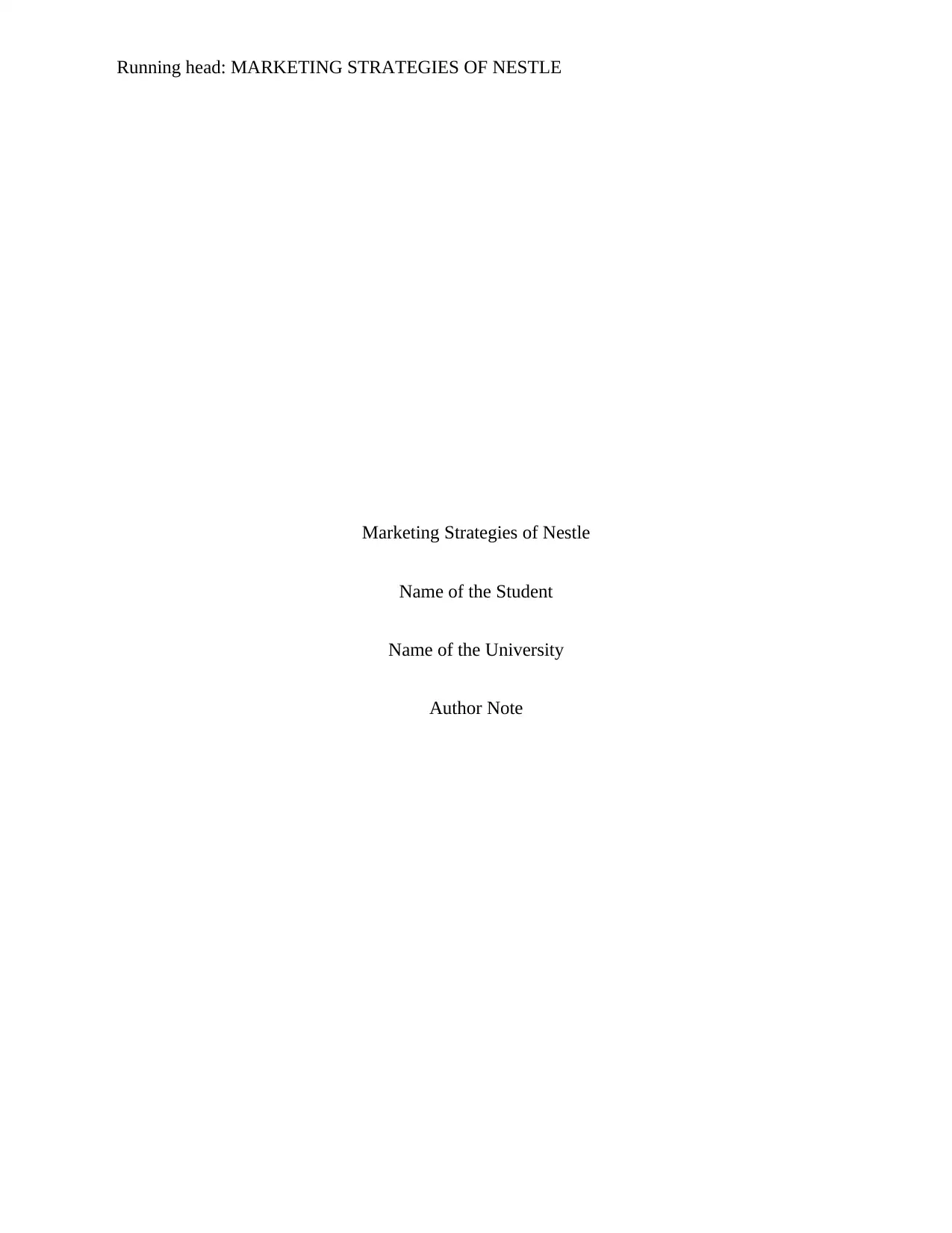
Running head: MARKETING STRATEGIES OF NESTLE
Marketing Strategies of Nestle
Name of the Student
Name of the University
Author Note
Marketing Strategies of Nestle
Name of the Student
Name of the University
Author Note
Paraphrase This Document
Need a fresh take? Get an instant paraphrase of this document with our AI Paraphraser
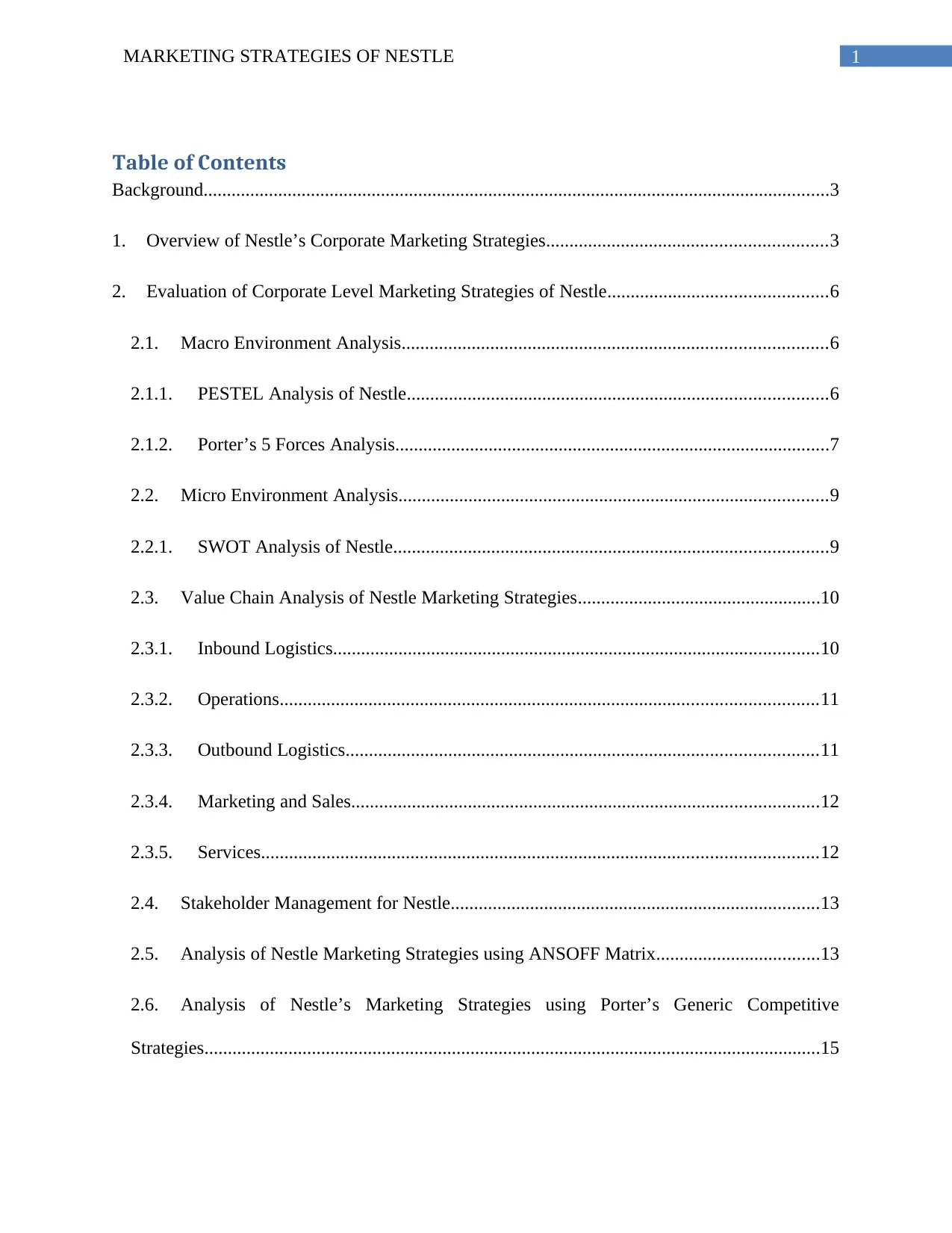
1MARKETING STRATEGIES OF NESTLE
Table of Contents
Background......................................................................................................................................3
1. Overview of Nestle’s Corporate Marketing Strategies............................................................3
2. Evaluation of Corporate Level Marketing Strategies of Nestle...............................................6
2.1. Macro Environment Analysis...........................................................................................6
2.1.1. PESTEL Analysis of Nestle..........................................................................................6
2.1.2. Porter’s 5 Forces Analysis.............................................................................................7
2.2. Micro Environment Analysis............................................................................................9
2.2.1. SWOT Analysis of Nestle.............................................................................................9
2.3. Value Chain Analysis of Nestle Marketing Strategies....................................................10
2.3.1. Inbound Logistics........................................................................................................10
2.3.2. Operations...................................................................................................................11
2.3.3. Outbound Logistics.....................................................................................................11
2.3.4. Marketing and Sales....................................................................................................12
2.3.5. Services.......................................................................................................................12
2.4. Stakeholder Management for Nestle...............................................................................13
2.5. Analysis of Nestle Marketing Strategies using ANSOFF Matrix...................................13
2.6. Analysis of Nestle’s Marketing Strategies using Porter’s Generic Competitive
Strategies....................................................................................................................................15
Table of Contents
Background......................................................................................................................................3
1. Overview of Nestle’s Corporate Marketing Strategies............................................................3
2. Evaluation of Corporate Level Marketing Strategies of Nestle...............................................6
2.1. Macro Environment Analysis...........................................................................................6
2.1.1. PESTEL Analysis of Nestle..........................................................................................6
2.1.2. Porter’s 5 Forces Analysis.............................................................................................7
2.2. Micro Environment Analysis............................................................................................9
2.2.1. SWOT Analysis of Nestle.............................................................................................9
2.3. Value Chain Analysis of Nestle Marketing Strategies....................................................10
2.3.1. Inbound Logistics........................................................................................................10
2.3.2. Operations...................................................................................................................11
2.3.3. Outbound Logistics.....................................................................................................11
2.3.4. Marketing and Sales....................................................................................................12
2.3.5. Services.......................................................................................................................12
2.4. Stakeholder Management for Nestle...............................................................................13
2.5. Analysis of Nestle Marketing Strategies using ANSOFF Matrix...................................13
2.6. Analysis of Nestle’s Marketing Strategies using Porter’s Generic Competitive
Strategies....................................................................................................................................15
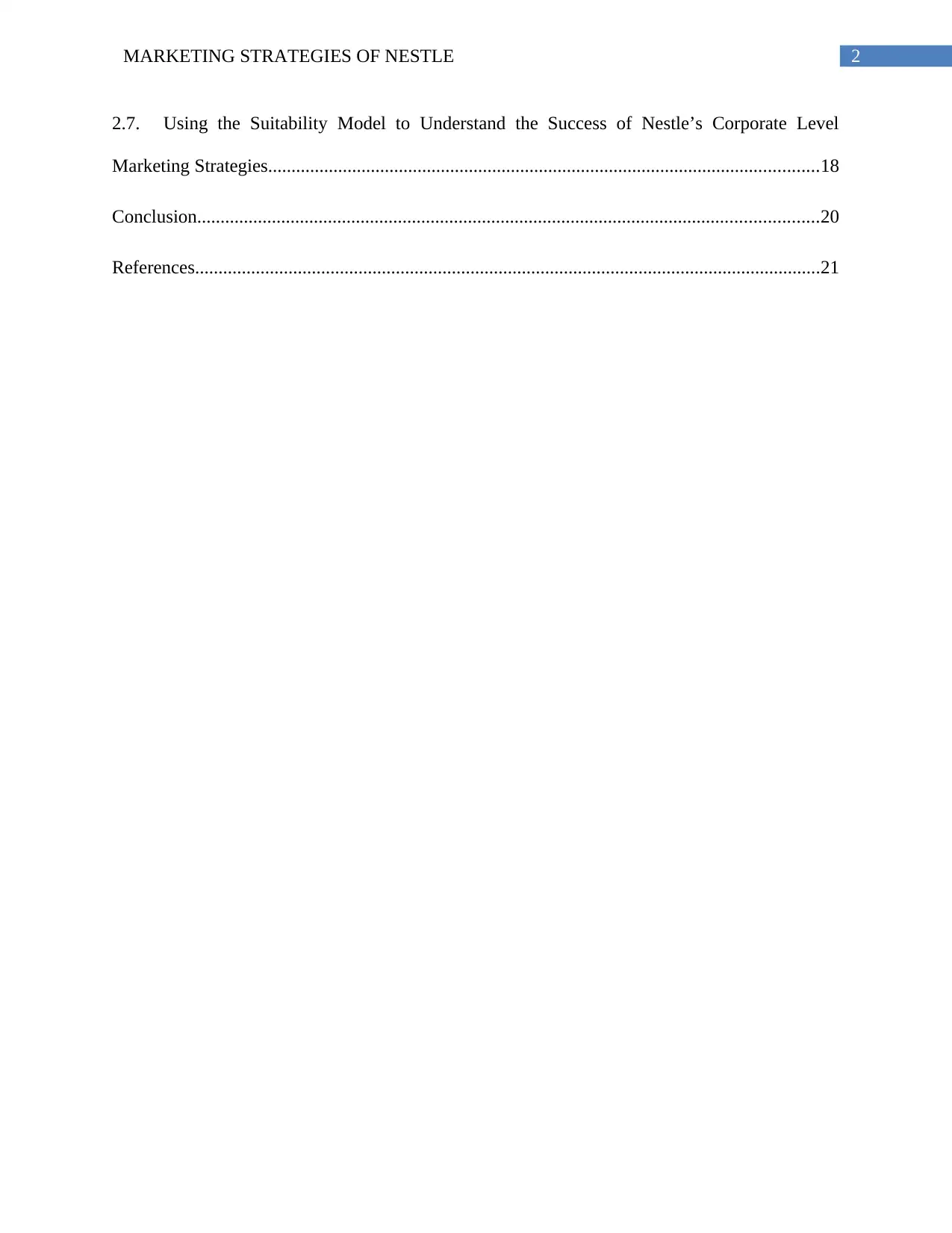
2MARKETING STRATEGIES OF NESTLE
2.7. Using the Suitability Model to Understand the Success of Nestle’s Corporate Level
Marketing Strategies......................................................................................................................18
Conclusion.....................................................................................................................................20
References......................................................................................................................................21
2.7. Using the Suitability Model to Understand the Success of Nestle’s Corporate Level
Marketing Strategies......................................................................................................................18
Conclusion.....................................................................................................................................20
References......................................................................................................................................21
⊘ This is a preview!⊘
Do you want full access?
Subscribe today to unlock all pages.

Trusted by 1+ million students worldwide
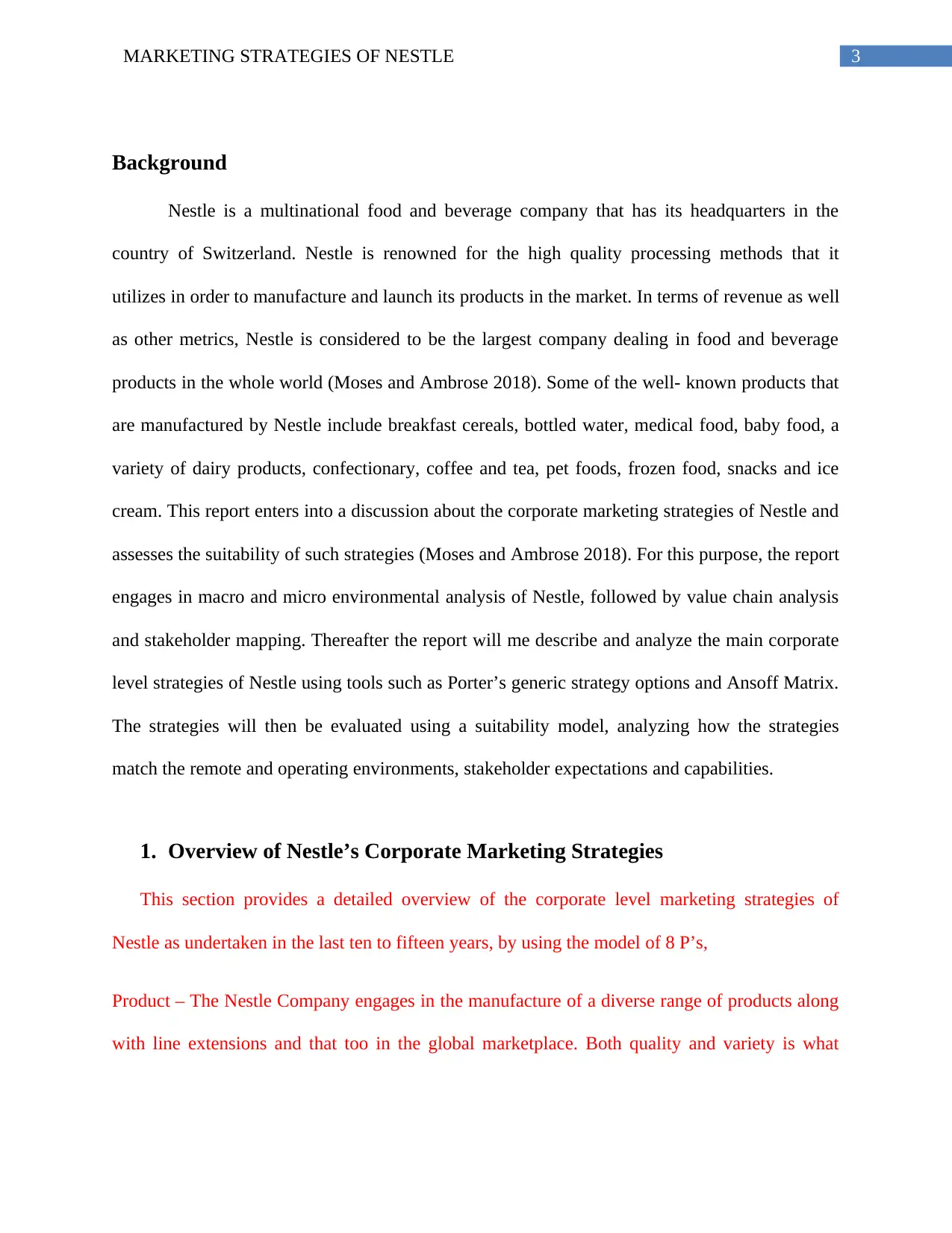
3MARKETING STRATEGIES OF NESTLE
Background
Nestle is a multinational food and beverage company that has its headquarters in the
country of Switzerland. Nestle is renowned for the high quality processing methods that it
utilizes in order to manufacture and launch its products in the market. In terms of revenue as well
as other metrics, Nestle is considered to be the largest company dealing in food and beverage
products in the whole world (Moses and Ambrose 2018). Some of the well- known products that
are manufactured by Nestle include breakfast cereals, bottled water, medical food, baby food, a
variety of dairy products, confectionary, coffee and tea, pet foods, frozen food, snacks and ice
cream. This report enters into a discussion about the corporate marketing strategies of Nestle and
assesses the suitability of such strategies (Moses and Ambrose 2018). For this purpose, the report
engages in macro and micro environmental analysis of Nestle, followed by value chain analysis
and stakeholder mapping. Thereafter the report will me describe and analyze the main corporate
level strategies of Nestle using tools such as Porter’s generic strategy options and Ansoff Matrix.
The strategies will then be evaluated using a suitability model, analyzing how the strategies
match the remote and operating environments, stakeholder expectations and capabilities.
1. Overview of Nestle’s Corporate Marketing Strategies
This section provides a detailed overview of the corporate level marketing strategies of
Nestle as undertaken in the last ten to fifteen years, by using the model of 8 P’s,
Product – The Nestle Company engages in the manufacture of a diverse range of products along
with line extensions and that too in the global marketplace. Both quality and variety is what
Background
Nestle is a multinational food and beverage company that has its headquarters in the
country of Switzerland. Nestle is renowned for the high quality processing methods that it
utilizes in order to manufacture and launch its products in the market. In terms of revenue as well
as other metrics, Nestle is considered to be the largest company dealing in food and beverage
products in the whole world (Moses and Ambrose 2018). Some of the well- known products that
are manufactured by Nestle include breakfast cereals, bottled water, medical food, baby food, a
variety of dairy products, confectionary, coffee and tea, pet foods, frozen food, snacks and ice
cream. This report enters into a discussion about the corporate marketing strategies of Nestle and
assesses the suitability of such strategies (Moses and Ambrose 2018). For this purpose, the report
engages in macro and micro environmental analysis of Nestle, followed by value chain analysis
and stakeholder mapping. Thereafter the report will me describe and analyze the main corporate
level strategies of Nestle using tools such as Porter’s generic strategy options and Ansoff Matrix.
The strategies will then be evaluated using a suitability model, analyzing how the strategies
match the remote and operating environments, stakeholder expectations and capabilities.
1. Overview of Nestle’s Corporate Marketing Strategies
This section provides a detailed overview of the corporate level marketing strategies of
Nestle as undertaken in the last ten to fifteen years, by using the model of 8 P’s,
Product – The Nestle Company engages in the manufacture of a diverse range of products along
with line extensions and that too in the global marketplace. Both quality and variety is what
Paraphrase This Document
Need a fresh take? Get an instant paraphrase of this document with our AI Paraphraser
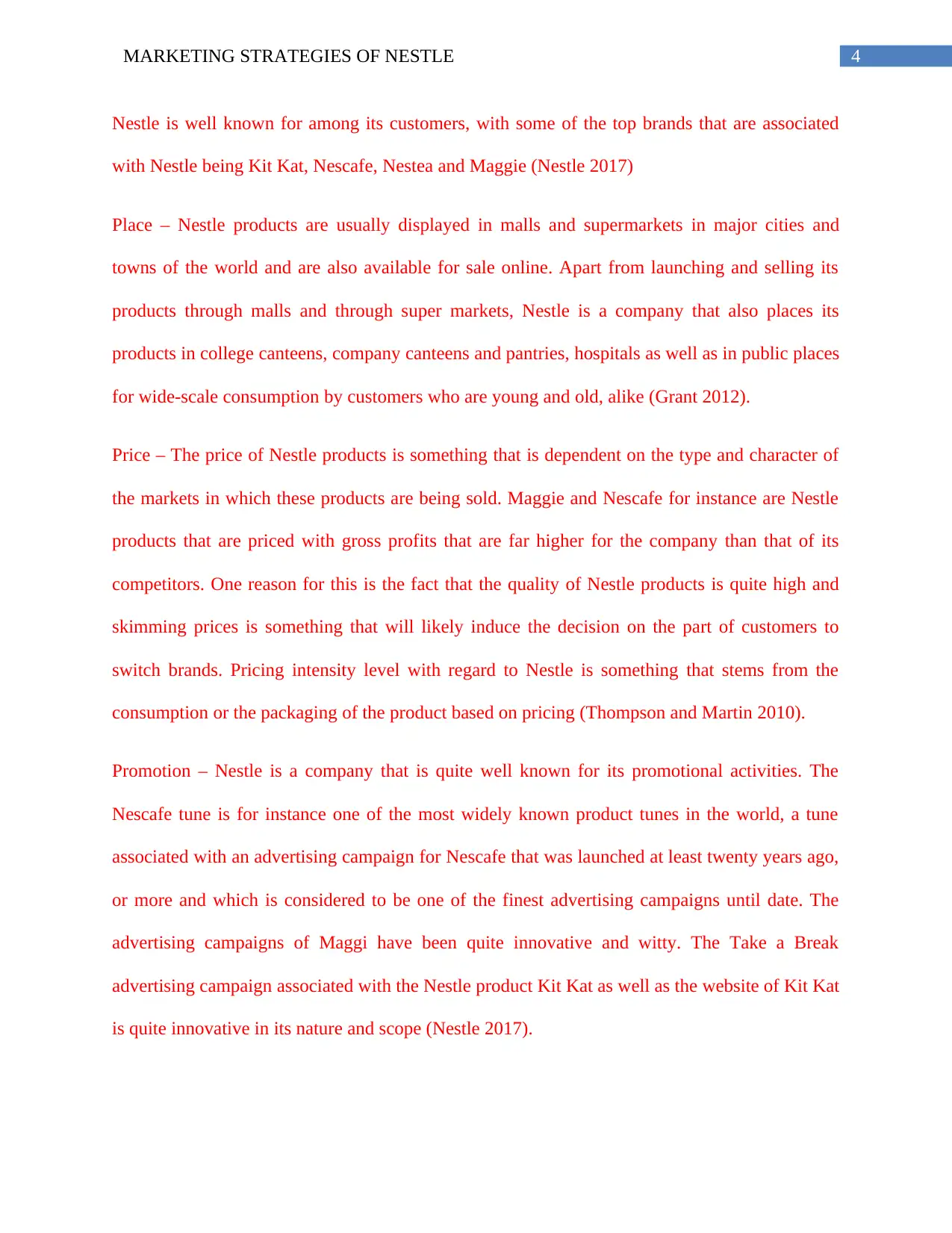
4MARKETING STRATEGIES OF NESTLE
Nestle is well known for among its customers, with some of the top brands that are associated
with Nestle being Kit Kat, Nescafe, Nestea and Maggie (Nestle 2017)
Place – Nestle products are usually displayed in malls and supermarkets in major cities and
towns of the world and are also available for sale online. Apart from launching and selling its
products through malls and through super markets, Nestle is a company that also places its
products in college canteens, company canteens and pantries, hospitals as well as in public places
for wide-scale consumption by customers who are young and old, alike (Grant 2012).
Price – The price of Nestle products is something that is dependent on the type and character of
the markets in which these products are being sold. Maggie and Nescafe for instance are Nestle
products that are priced with gross profits that are far higher for the company than that of its
competitors. One reason for this is the fact that the quality of Nestle products is quite high and
skimming prices is something that will likely induce the decision on the part of customers to
switch brands. Pricing intensity level with regard to Nestle is something that stems from the
consumption or the packaging of the product based on pricing (Thompson and Martin 2010).
Promotion – Nestle is a company that is quite well known for its promotional activities. The
Nescafe tune is for instance one of the most widely known product tunes in the world, a tune
associated with an advertising campaign for Nescafe that was launched at least twenty years ago,
or more and which is considered to be one of the finest advertising campaigns until date. The
advertising campaigns of Maggi have been quite innovative and witty. The Take a Break
advertising campaign associated with the Nestle product Kit Kat as well as the website of Kit Kat
is quite innovative in its nature and scope (Nestle 2017).
Nestle is well known for among its customers, with some of the top brands that are associated
with Nestle being Kit Kat, Nescafe, Nestea and Maggie (Nestle 2017)
Place – Nestle products are usually displayed in malls and supermarkets in major cities and
towns of the world and are also available for sale online. Apart from launching and selling its
products through malls and through super markets, Nestle is a company that also places its
products in college canteens, company canteens and pantries, hospitals as well as in public places
for wide-scale consumption by customers who are young and old, alike (Grant 2012).
Price – The price of Nestle products is something that is dependent on the type and character of
the markets in which these products are being sold. Maggie and Nescafe for instance are Nestle
products that are priced with gross profits that are far higher for the company than that of its
competitors. One reason for this is the fact that the quality of Nestle products is quite high and
skimming prices is something that will likely induce the decision on the part of customers to
switch brands. Pricing intensity level with regard to Nestle is something that stems from the
consumption or the packaging of the product based on pricing (Thompson and Martin 2010).
Promotion – Nestle is a company that is quite well known for its promotional activities. The
Nescafe tune is for instance one of the most widely known product tunes in the world, a tune
associated with an advertising campaign for Nescafe that was launched at least twenty years ago,
or more and which is considered to be one of the finest advertising campaigns until date. The
advertising campaigns of Maggi have been quite innovative and witty. The Take a Break
advertising campaign associated with the Nestle product Kit Kat as well as the website of Kit Kat
is quite innovative in its nature and scope (Nestle 2017).
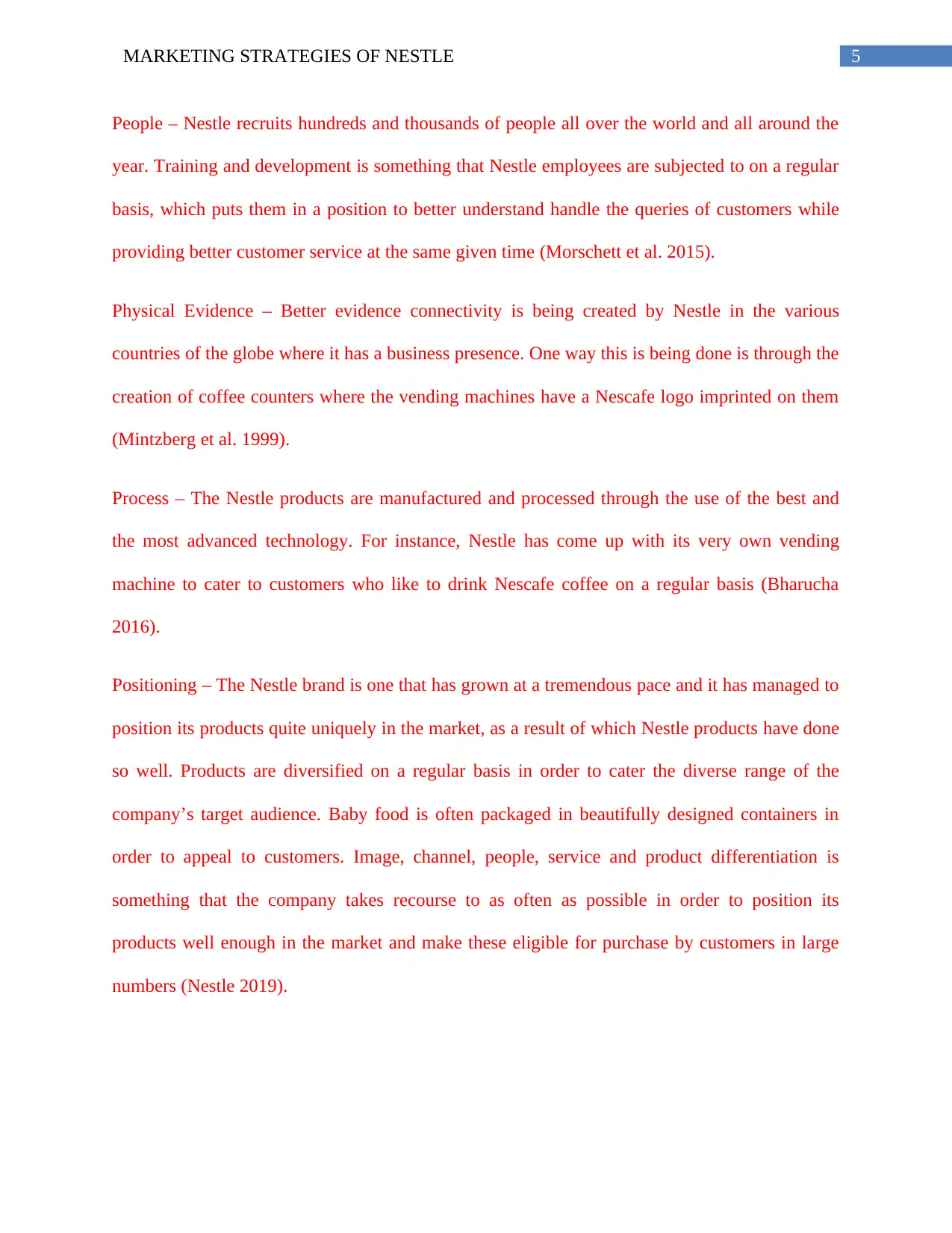
5MARKETING STRATEGIES OF NESTLE
People – Nestle recruits hundreds and thousands of people all over the world and all around the
year. Training and development is something that Nestle employees are subjected to on a regular
basis, which puts them in a position to better understand handle the queries of customers while
providing better customer service at the same given time (Morschett et al. 2015).
Physical Evidence – Better evidence connectivity is being created by Nestle in the various
countries of the globe where it has a business presence. One way this is being done is through the
creation of coffee counters where the vending machines have a Nescafe logo imprinted on them
(Mintzberg et al. 1999).
Process – The Nestle products are manufactured and processed through the use of the best and
the most advanced technology. For instance, Nestle has come up with its very own vending
machine to cater to customers who like to drink Nescafe coffee on a regular basis (Bharucha
2016).
Positioning – The Nestle brand is one that has grown at a tremendous pace and it has managed to
position its products quite uniquely in the market, as a result of which Nestle products have done
so well. Products are diversified on a regular basis in order to cater the diverse range of the
company’s target audience. Baby food is often packaged in beautifully designed containers in
order to appeal to customers. Image, channel, people, service and product differentiation is
something that the company takes recourse to as often as possible in order to position its
products well enough in the market and make these eligible for purchase by customers in large
numbers (Nestle 2019).
People – Nestle recruits hundreds and thousands of people all over the world and all around the
year. Training and development is something that Nestle employees are subjected to on a regular
basis, which puts them in a position to better understand handle the queries of customers while
providing better customer service at the same given time (Morschett et al. 2015).
Physical Evidence – Better evidence connectivity is being created by Nestle in the various
countries of the globe where it has a business presence. One way this is being done is through the
creation of coffee counters where the vending machines have a Nescafe logo imprinted on them
(Mintzberg et al. 1999).
Process – The Nestle products are manufactured and processed through the use of the best and
the most advanced technology. For instance, Nestle has come up with its very own vending
machine to cater to customers who like to drink Nescafe coffee on a regular basis (Bharucha
2016).
Positioning – The Nestle brand is one that has grown at a tremendous pace and it has managed to
position its products quite uniquely in the market, as a result of which Nestle products have done
so well. Products are diversified on a regular basis in order to cater the diverse range of the
company’s target audience. Baby food is often packaged in beautifully designed containers in
order to appeal to customers. Image, channel, people, service and product differentiation is
something that the company takes recourse to as often as possible in order to position its
products well enough in the market and make these eligible for purchase by customers in large
numbers (Nestle 2019).
⊘ This is a preview!⊘
Do you want full access?
Subscribe today to unlock all pages.

Trusted by 1+ million students worldwide
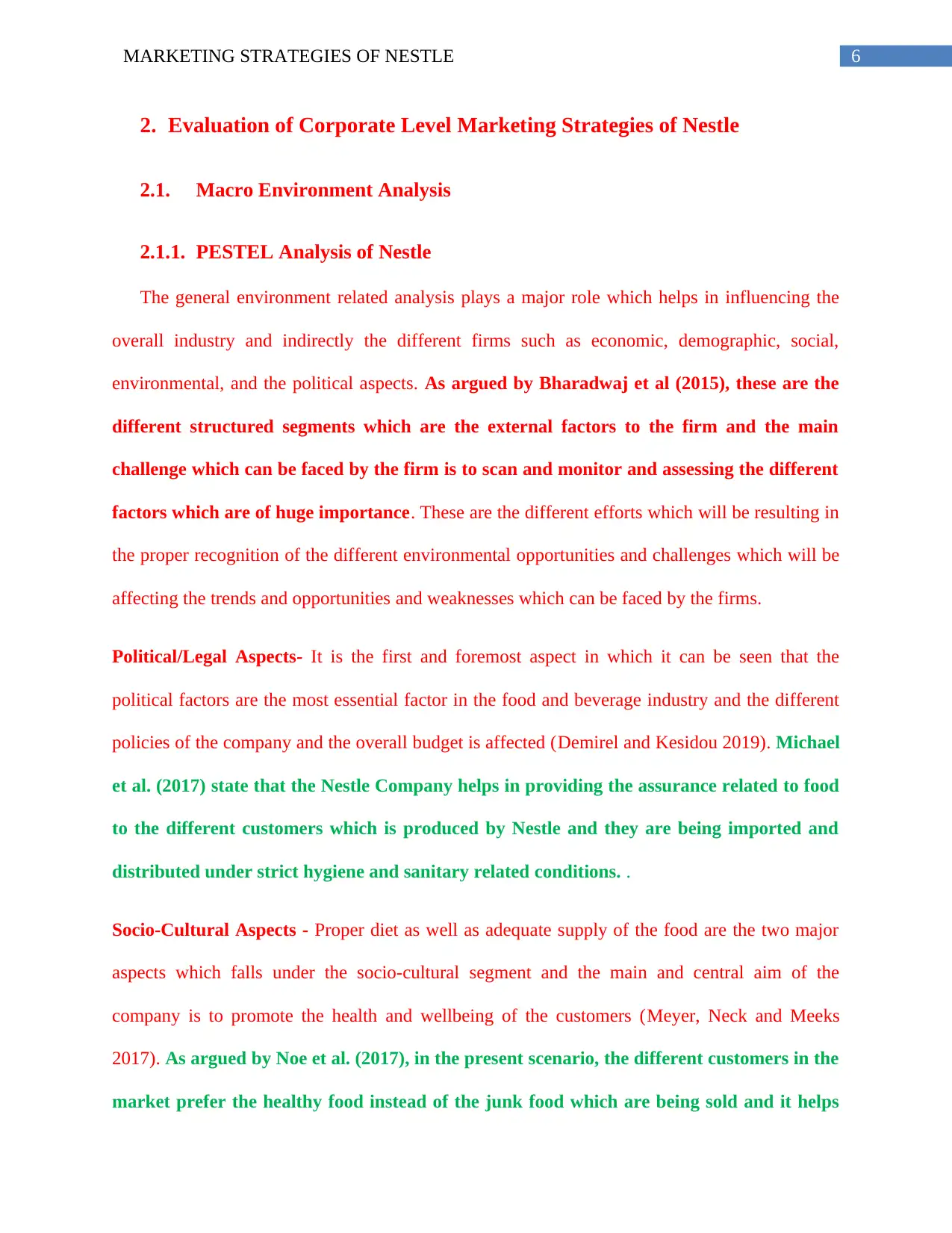
6MARKETING STRATEGIES OF NESTLE
2. Evaluation of Corporate Level Marketing Strategies of Nestle
2.1. Macro Environment Analysis
2.1.1. PESTEL Analysis of Nestle
The general environment related analysis plays a major role which helps in influencing the
overall industry and indirectly the different firms such as economic, demographic, social,
environmental, and the political aspects. As argued by Bharadwaj et al (2015), these are the
different structured segments which are the external factors to the firm and the main
challenge which can be faced by the firm is to scan and monitor and assessing the different
factors which are of huge importance. These are the different efforts which will be resulting in
the proper recognition of the different environmental opportunities and challenges which will be
affecting the trends and opportunities and weaknesses which can be faced by the firms.
Political/Legal Aspects- It is the first and foremost aspect in which it can be seen that the
political factors are the most essential factor in the food and beverage industry and the different
policies of the company and the overall budget is affected (Demirel and Kesidou 2019). Michael
et al. (2017) state that the Nestle Company helps in providing the assurance related to food
to the different customers which is produced by Nestle and they are being imported and
distributed under strict hygiene and sanitary related conditions. .
Socio-Cultural Aspects - Proper diet as well as adequate supply of the food are the two major
aspects which falls under the socio-cultural segment and the main and central aim of the
company is to promote the health and wellbeing of the customers (Meyer, Neck and Meeks
2017). As argued by Noe et al. (2017), in the present scenario, the different customers in the
market prefer the healthy food instead of the junk food which are being sold and it helps
2. Evaluation of Corporate Level Marketing Strategies of Nestle
2.1. Macro Environment Analysis
2.1.1. PESTEL Analysis of Nestle
The general environment related analysis plays a major role which helps in influencing the
overall industry and indirectly the different firms such as economic, demographic, social,
environmental, and the political aspects. As argued by Bharadwaj et al (2015), these are the
different structured segments which are the external factors to the firm and the main
challenge which can be faced by the firm is to scan and monitor and assessing the different
factors which are of huge importance. These are the different efforts which will be resulting in
the proper recognition of the different environmental opportunities and challenges which will be
affecting the trends and opportunities and weaknesses which can be faced by the firms.
Political/Legal Aspects- It is the first and foremost aspect in which it can be seen that the
political factors are the most essential factor in the food and beverage industry and the different
policies of the company and the overall budget is affected (Demirel and Kesidou 2019). Michael
et al. (2017) state that the Nestle Company helps in providing the assurance related to food
to the different customers which is produced by Nestle and they are being imported and
distributed under strict hygiene and sanitary related conditions. .
Socio-Cultural Aspects - Proper diet as well as adequate supply of the food are the two major
aspects which falls under the socio-cultural segment and the main and central aim of the
company is to promote the health and wellbeing of the customers (Meyer, Neck and Meeks
2017). As argued by Noe et al. (2017), in the present scenario, the different customers in the
market prefer the healthy food instead of the junk food which are being sold and it helps
Paraphrase This Document
Need a fresh take? Get an instant paraphrase of this document with our AI Paraphraser
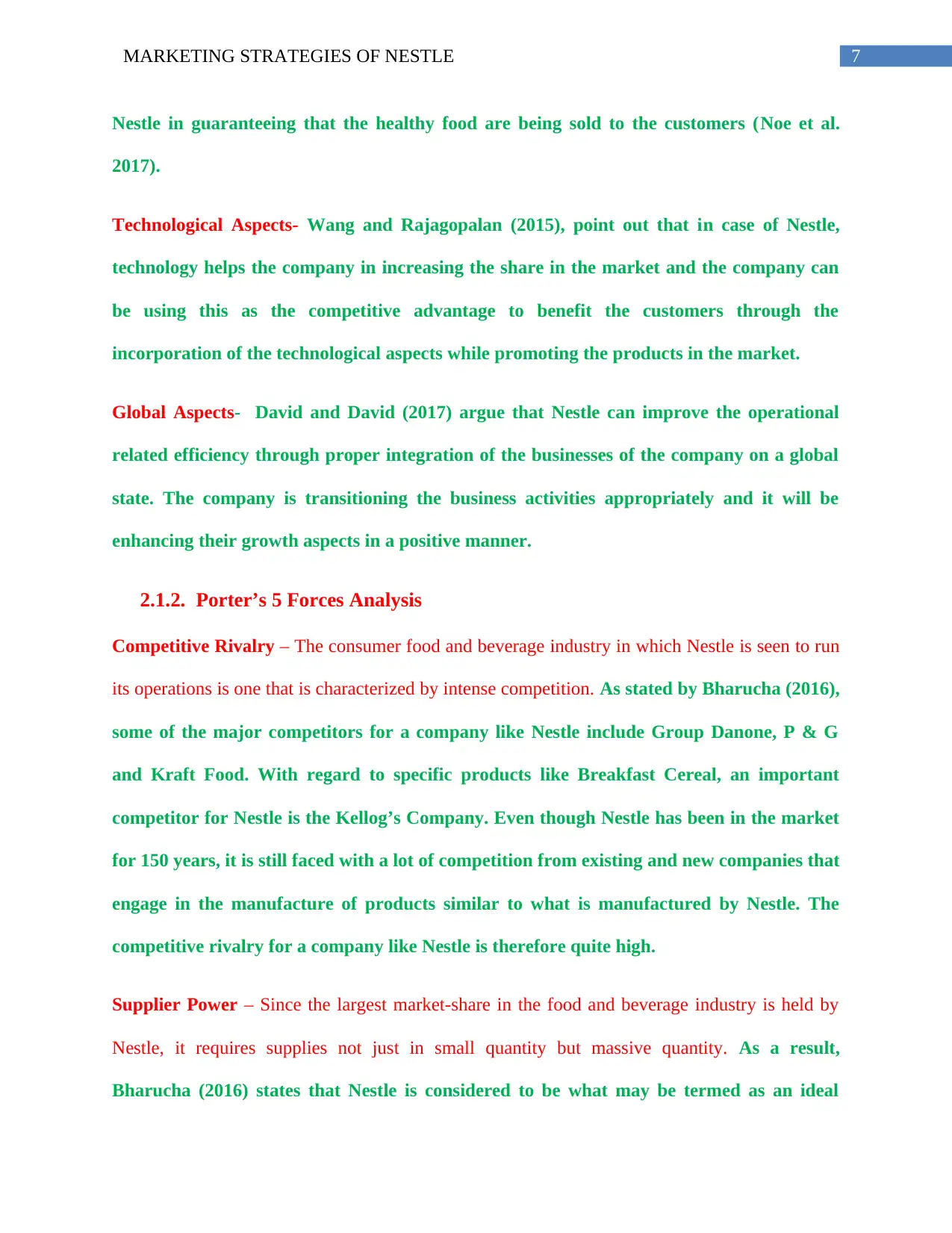
7MARKETING STRATEGIES OF NESTLE
Nestle in guaranteeing that the healthy food are being sold to the customers (Noe et al.
2017).
Technological Aspects- Wang and Rajagopalan (2015), point out that in case of Nestle,
technology helps the company in increasing the share in the market and the company can
be using this as the competitive advantage to benefit the customers through the
incorporation of the technological aspects while promoting the products in the market.
Global Aspects- David and David (2017) argue that Nestle can improve the operational
related efficiency through proper integration of the businesses of the company on a global
state. The company is transitioning the business activities appropriately and it will be
enhancing their growth aspects in a positive manner.
2.1.2. Porter’s 5 Forces Analysis
Competitive Rivalry – The consumer food and beverage industry in which Nestle is seen to run
its operations is one that is characterized by intense competition. As stated by Bharucha (2016),
some of the major competitors for a company like Nestle include Group Danone, P & G
and Kraft Food. With regard to specific products like Breakfast Cereal, an important
competitor for Nestle is the Kellog’s Company. Even though Nestle has been in the market
for 150 years, it is still faced with a lot of competition from existing and new companies that
engage in the manufacture of products similar to what is manufactured by Nestle. The
competitive rivalry for a company like Nestle is therefore quite high.
Supplier Power – Since the largest market-share in the food and beverage industry is held by
Nestle, it requires supplies not just in small quantity but massive quantity. As a result,
Bharucha (2016) states that Nestle is considered to be what may be termed as an ideal
Nestle in guaranteeing that the healthy food are being sold to the customers (Noe et al.
2017).
Technological Aspects- Wang and Rajagopalan (2015), point out that in case of Nestle,
technology helps the company in increasing the share in the market and the company can
be using this as the competitive advantage to benefit the customers through the
incorporation of the technological aspects while promoting the products in the market.
Global Aspects- David and David (2017) argue that Nestle can improve the operational
related efficiency through proper integration of the businesses of the company on a global
state. The company is transitioning the business activities appropriately and it will be
enhancing their growth aspects in a positive manner.
2.1.2. Porter’s 5 Forces Analysis
Competitive Rivalry – The consumer food and beverage industry in which Nestle is seen to run
its operations is one that is characterized by intense competition. As stated by Bharucha (2016),
some of the major competitors for a company like Nestle include Group Danone, P & G
and Kraft Food. With regard to specific products like Breakfast Cereal, an important
competitor for Nestle is the Kellog’s Company. Even though Nestle has been in the market
for 150 years, it is still faced with a lot of competition from existing and new companies that
engage in the manufacture of products similar to what is manufactured by Nestle. The
competitive rivalry for a company like Nestle is therefore quite high.
Supplier Power – Since the largest market-share in the food and beverage industry is held by
Nestle, it requires supplies not just in small quantity but massive quantity. As a result,
Bharucha (2016) states that Nestle is considered to be what may be termed as an ideal
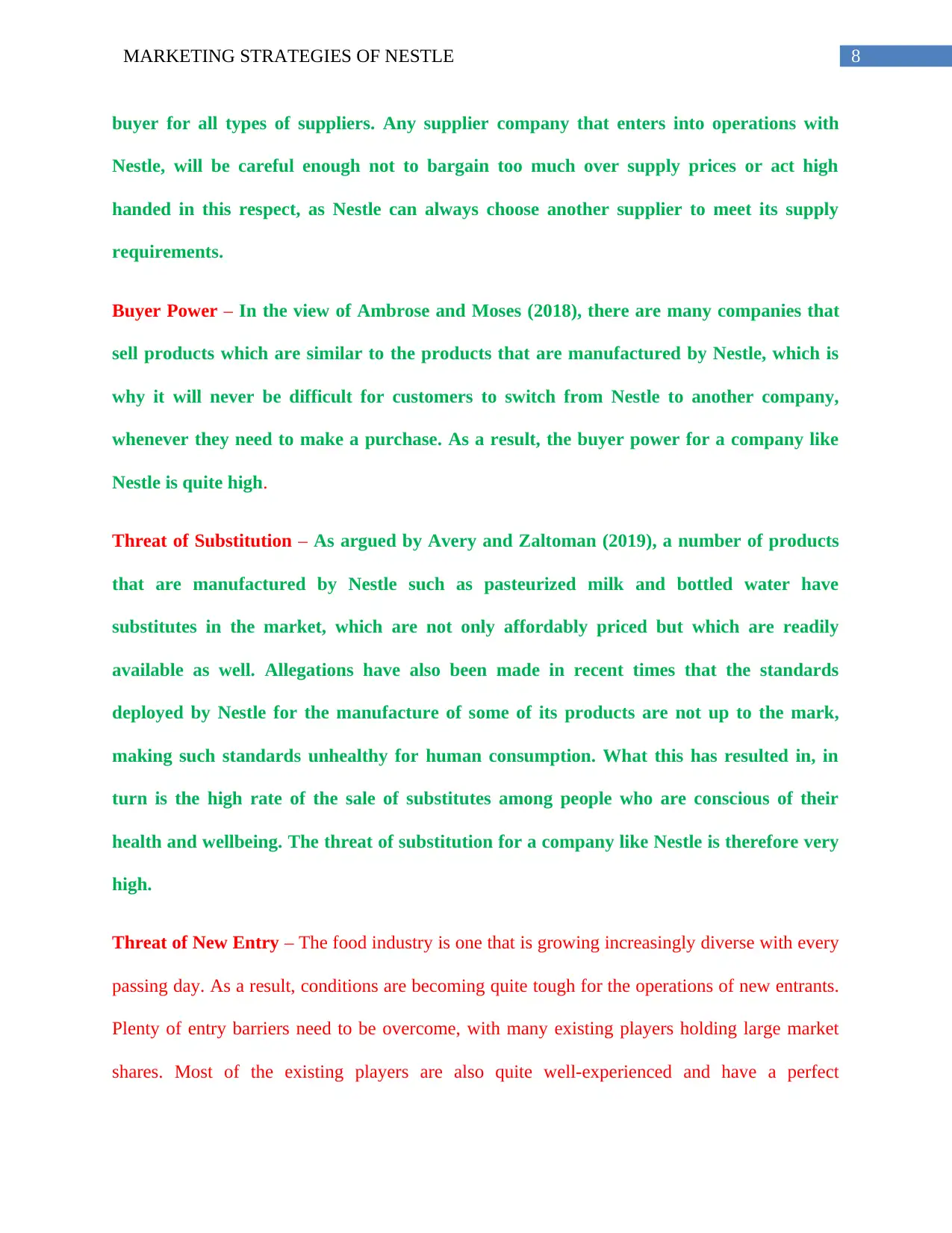
8MARKETING STRATEGIES OF NESTLE
buyer for all types of suppliers. Any supplier company that enters into operations with
Nestle, will be careful enough not to bargain too much over supply prices or act high
handed in this respect, as Nestle can always choose another supplier to meet its supply
requirements.
Buyer Power – In the view of Ambrose and Moses (2018), there are many companies that
sell products which are similar to the products that are manufactured by Nestle, which is
why it will never be difficult for customers to switch from Nestle to another company,
whenever they need to make a purchase. As a result, the buyer power for a company like
Nestle is quite high.
Threat of Substitution – As argued by Avery and Zaltoman (2019), a number of products
that are manufactured by Nestle such as pasteurized milk and bottled water have
substitutes in the market, which are not only affordably priced but which are readily
available as well. Allegations have also been made in recent times that the standards
deployed by Nestle for the manufacture of some of its products are not up to the mark,
making such standards unhealthy for human consumption. What this has resulted in, in
turn is the high rate of the sale of substitutes among people who are conscious of their
health and wellbeing. The threat of substitution for a company like Nestle is therefore very
high.
Threat of New Entry – The food industry is one that is growing increasingly diverse with every
passing day. As a result, conditions are becoming quite tough for the operations of new entrants.
Plenty of entry barriers need to be overcome, with many existing players holding large market
shares. Most of the existing players are also quite well-experienced and have a perfect
buyer for all types of suppliers. Any supplier company that enters into operations with
Nestle, will be careful enough not to bargain too much over supply prices or act high
handed in this respect, as Nestle can always choose another supplier to meet its supply
requirements.
Buyer Power – In the view of Ambrose and Moses (2018), there are many companies that
sell products which are similar to the products that are manufactured by Nestle, which is
why it will never be difficult for customers to switch from Nestle to another company,
whenever they need to make a purchase. As a result, the buyer power for a company like
Nestle is quite high.
Threat of Substitution – As argued by Avery and Zaltoman (2019), a number of products
that are manufactured by Nestle such as pasteurized milk and bottled water have
substitutes in the market, which are not only affordably priced but which are readily
available as well. Allegations have also been made in recent times that the standards
deployed by Nestle for the manufacture of some of its products are not up to the mark,
making such standards unhealthy for human consumption. What this has resulted in, in
turn is the high rate of the sale of substitutes among people who are conscious of their
health and wellbeing. The threat of substitution for a company like Nestle is therefore very
high.
Threat of New Entry – The food industry is one that is growing increasingly diverse with every
passing day. As a result, conditions are becoming quite tough for the operations of new entrants.
Plenty of entry barriers need to be overcome, with many existing players holding large market
shares. Most of the existing players are also quite well-experienced and have a perfect
⊘ This is a preview!⊘
Do you want full access?
Subscribe today to unlock all pages.

Trusted by 1+ million students worldwide
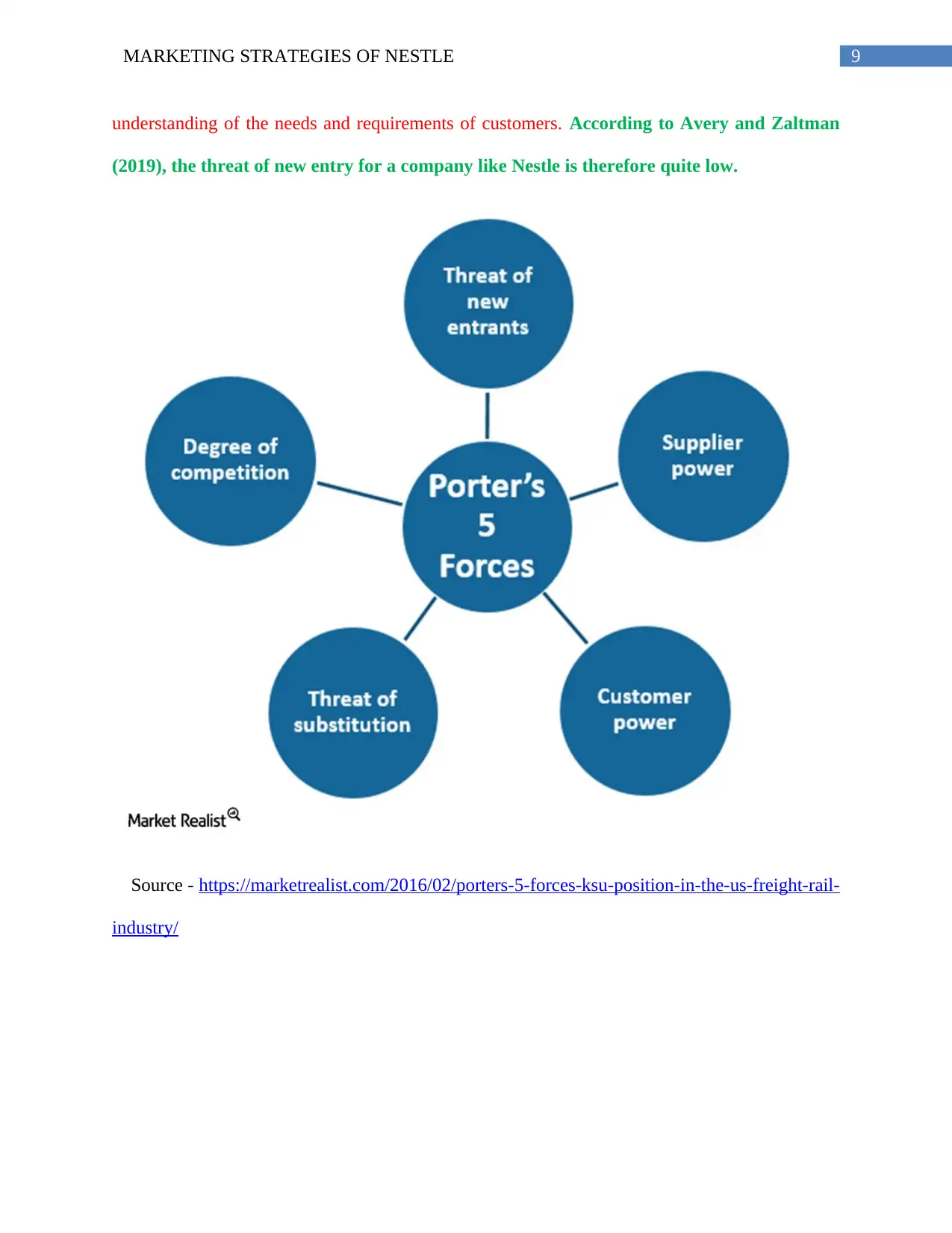
9MARKETING STRATEGIES OF NESTLE
understanding of the needs and requirements of customers. According to Avery and Zaltman
(2019), the threat of new entry for a company like Nestle is therefore quite low.
Source - https://marketrealist.com/2016/02/porters-5-forces-ksu-position-in-the-us-freight-rail-
industry/
understanding of the needs and requirements of customers. According to Avery and Zaltman
(2019), the threat of new entry for a company like Nestle is therefore quite low.
Source - https://marketrealist.com/2016/02/porters-5-forces-ksu-position-in-the-us-freight-rail-
industry/
Paraphrase This Document
Need a fresh take? Get an instant paraphrase of this document with our AI Paraphraser
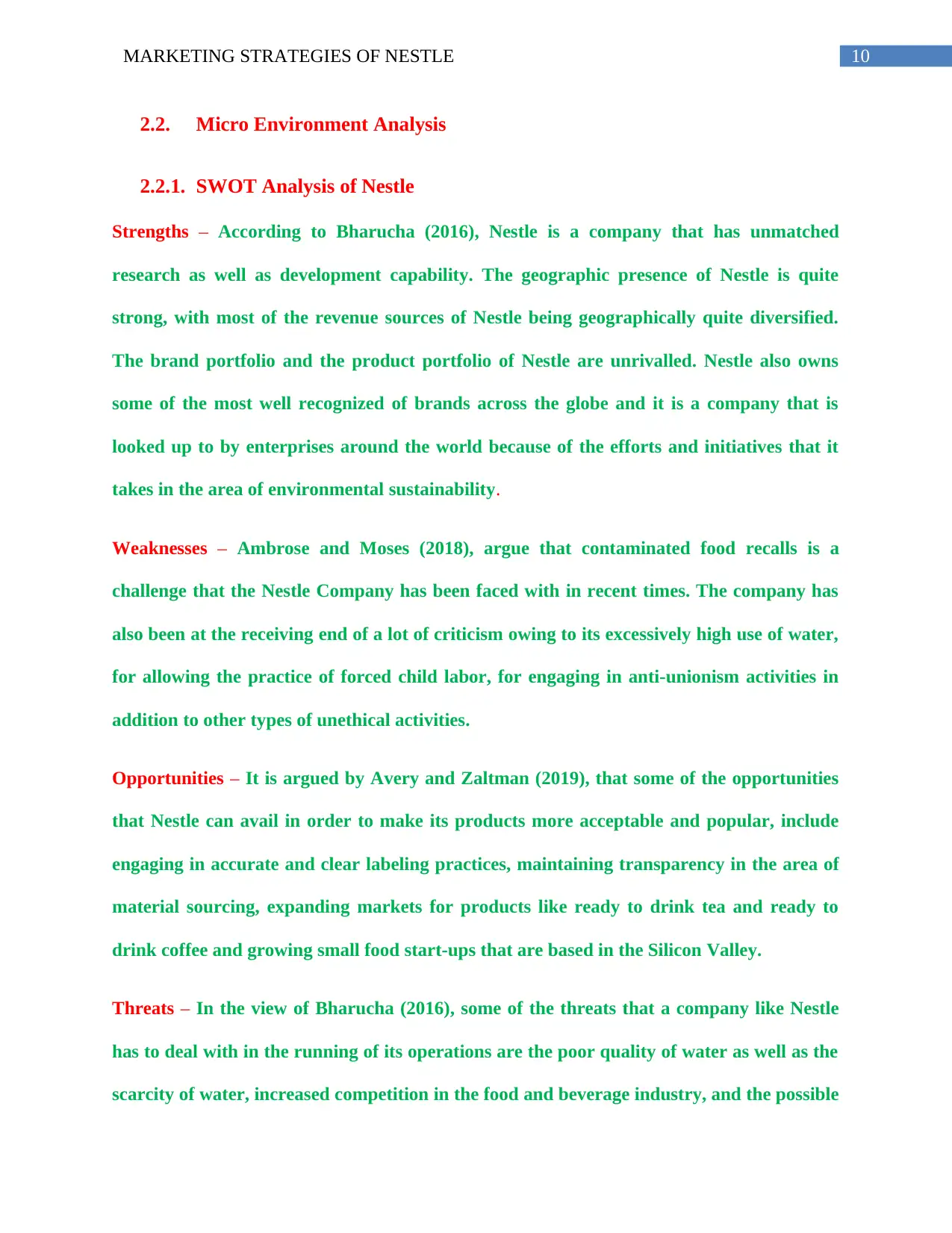
10MARKETING STRATEGIES OF NESTLE
2.2. Micro Environment Analysis
2.2.1. SWOT Analysis of Nestle
Strengths – According to Bharucha (2016), Nestle is a company that has unmatched
research as well as development capability. The geographic presence of Nestle is quite
strong, with most of the revenue sources of Nestle being geographically quite diversified.
The brand portfolio and the product portfolio of Nestle are unrivalled. Nestle also owns
some of the most well recognized of brands across the globe and it is a company that is
looked up to by enterprises around the world because of the efforts and initiatives that it
takes in the area of environmental sustainability.
Weaknesses – Ambrose and Moses (2018), argue that contaminated food recalls is a
challenge that the Nestle Company has been faced with in recent times. The company has
also been at the receiving end of a lot of criticism owing to its excessively high use of water,
for allowing the practice of forced child labor, for engaging in anti-unionism activities in
addition to other types of unethical activities.
Opportunities – It is argued by Avery and Zaltman (2019), that some of the opportunities
that Nestle can avail in order to make its products more acceptable and popular, include
engaging in accurate and clear labeling practices, maintaining transparency in the area of
material sourcing, expanding markets for products like ready to drink tea and ready to
drink coffee and growing small food start-ups that are based in the Silicon Valley.
Threats – In the view of Bharucha (2016), some of the threats that a company like Nestle
has to deal with in the running of its operations are the poor quality of water as well as the
scarcity of water, increased competition in the food and beverage industry, and the possible
2.2. Micro Environment Analysis
2.2.1. SWOT Analysis of Nestle
Strengths – According to Bharucha (2016), Nestle is a company that has unmatched
research as well as development capability. The geographic presence of Nestle is quite
strong, with most of the revenue sources of Nestle being geographically quite diversified.
The brand portfolio and the product portfolio of Nestle are unrivalled. Nestle also owns
some of the most well recognized of brands across the globe and it is a company that is
looked up to by enterprises around the world because of the efforts and initiatives that it
takes in the area of environmental sustainability.
Weaknesses – Ambrose and Moses (2018), argue that contaminated food recalls is a
challenge that the Nestle Company has been faced with in recent times. The company has
also been at the receiving end of a lot of criticism owing to its excessively high use of water,
for allowing the practice of forced child labor, for engaging in anti-unionism activities in
addition to other types of unethical activities.
Opportunities – It is argued by Avery and Zaltman (2019), that some of the opportunities
that Nestle can avail in order to make its products more acceptable and popular, include
engaging in accurate and clear labeling practices, maintaining transparency in the area of
material sourcing, expanding markets for products like ready to drink tea and ready to
drink coffee and growing small food start-ups that are based in the Silicon Valley.
Threats – In the view of Bharucha (2016), some of the threats that a company like Nestle
has to deal with in the running of its operations are the poor quality of water as well as the
scarcity of water, increased competition in the food and beverage industry, and the possible
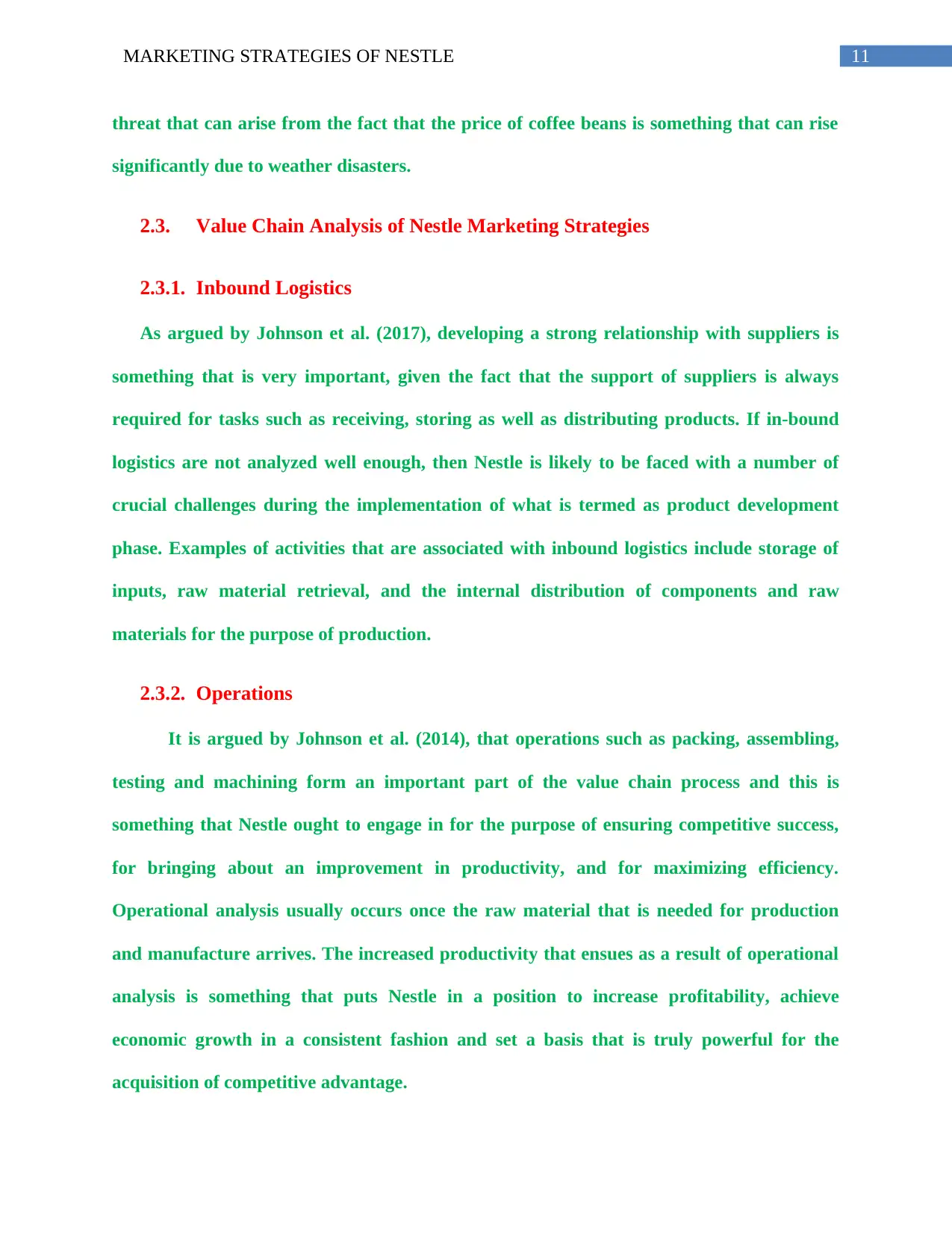
11MARKETING STRATEGIES OF NESTLE
threat that can arise from the fact that the price of coffee beans is something that can rise
significantly due to weather disasters.
2.3. Value Chain Analysis of Nestle Marketing Strategies
2.3.1. Inbound Logistics
As argued by Johnson et al. (2017), developing a strong relationship with suppliers is
something that is very important, given the fact that the support of suppliers is always
required for tasks such as receiving, storing as well as distributing products. If in-bound
logistics are not analyzed well enough, then Nestle is likely to be faced with a number of
crucial challenges during the implementation of what is termed as product development
phase. Examples of activities that are associated with inbound logistics include storage of
inputs, raw material retrieval, and the internal distribution of components and raw
materials for the purpose of production.
2.3.2. Operations
It is argued by Johnson et al. (2014), that operations such as packing, assembling,
testing and machining form an important part of the value chain process and this is
something that Nestle ought to engage in for the purpose of ensuring competitive success,
for bringing about an improvement in productivity, and for maximizing efficiency.
Operational analysis usually occurs once the raw material that is needed for production
and manufacture arrives. The increased productivity that ensues as a result of operational
analysis is something that puts Nestle in a position to increase profitability, achieve
economic growth in a consistent fashion and set a basis that is truly powerful for the
acquisition of competitive advantage.
threat that can arise from the fact that the price of coffee beans is something that can rise
significantly due to weather disasters.
2.3. Value Chain Analysis of Nestle Marketing Strategies
2.3.1. Inbound Logistics
As argued by Johnson et al. (2017), developing a strong relationship with suppliers is
something that is very important, given the fact that the support of suppliers is always
required for tasks such as receiving, storing as well as distributing products. If in-bound
logistics are not analyzed well enough, then Nestle is likely to be faced with a number of
crucial challenges during the implementation of what is termed as product development
phase. Examples of activities that are associated with inbound logistics include storage of
inputs, raw material retrieval, and the internal distribution of components and raw
materials for the purpose of production.
2.3.2. Operations
It is argued by Johnson et al. (2014), that operations such as packing, assembling,
testing and machining form an important part of the value chain process and this is
something that Nestle ought to engage in for the purpose of ensuring competitive success,
for bringing about an improvement in productivity, and for maximizing efficiency.
Operational analysis usually occurs once the raw material that is needed for production
and manufacture arrives. The increased productivity that ensues as a result of operational
analysis is something that puts Nestle in a position to increase profitability, achieve
economic growth in a consistent fashion and set a basis that is truly powerful for the
acquisition of competitive advantage.
⊘ This is a preview!⊘
Do you want full access?
Subscribe today to unlock all pages.

Trusted by 1+ million students worldwide
1 out of 28
Related Documents
Your All-in-One AI-Powered Toolkit for Academic Success.
+13062052269
info@desklib.com
Available 24*7 on WhatsApp / Email
![[object Object]](/_next/static/media/star-bottom.7253800d.svg)
Unlock your academic potential
Copyright © 2020–2025 A2Z Services. All Rights Reserved. Developed and managed by ZUCOL.





